LSC UoS BA Business Studies: OCBC Bank Credit Card Case Study Analysis
VerifiedAdded on 2023/06/06
|17
|4537
|417
Case Study
AI Summary
This case study examines the customer loyalty and satisfaction challenges faced by OCBC Bank in its credit card business within the highly competitive Singaporean market. The analysis investigates the bank's underperformance relative to competitors, identifying key issues such as declining sales and a last-place ranking in customer satisfaction. The study utilizes the SERVEQUAL model to analyze service quality gaps, including knowledge, standards, delivery, and communications gaps. It also explores the impact of these gaps on customer satisfaction and loyalty. The case study provides a detailed overview of the credit card industry, the bank's position, and the application of the SERVEQUAL model to diagnose problems, with the aim of recommending strategies to improve customer loyalty and market performance. The study also examines the role of customer loyalty programs and communication tools in bridging service gaps and enhancing customer satisfaction.

Integrated Case Study
Paraphrase This Document
Need a fresh take? Get an instant paraphrase of this document with our AI Paraphraser
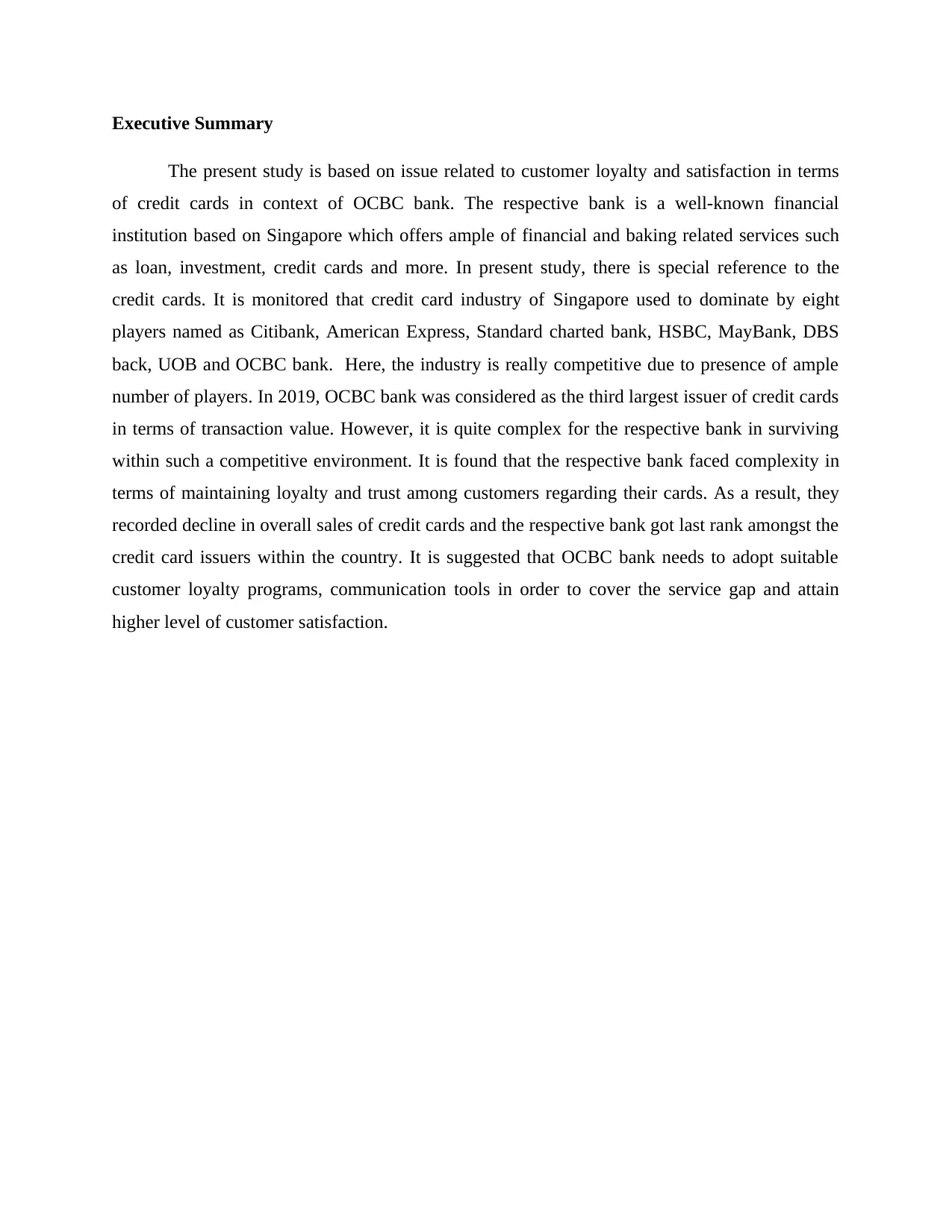
Executive Summary
The present study is based on issue related to customer loyalty and satisfaction in terms
of credit cards in context of OCBC bank. The respective bank is a well-known financial
institution based on Singapore which offers ample of financial and baking related services such
as loan, investment, credit cards and more. In present study, there is special reference to the
credit cards. It is monitored that credit card industry of Singapore used to dominate by eight
players named as Citibank, American Express, Standard charted bank, HSBC, MayBank, DBS
back, UOB and OCBC bank. Here, the industry is really competitive due to presence of ample
number of players. In 2019, OCBC bank was considered as the third largest issuer of credit cards
in terms of transaction value. However, it is quite complex for the respective bank in surviving
within such a competitive environment. It is found that the respective bank faced complexity in
terms of maintaining loyalty and trust among customers regarding their cards. As a result, they
recorded decline in overall sales of credit cards and the respective bank got last rank amongst the
credit card issuers within the country. It is suggested that OCBC bank needs to adopt suitable
customer loyalty programs, communication tools in order to cover the service gap and attain
higher level of customer satisfaction.
The present study is based on issue related to customer loyalty and satisfaction in terms
of credit cards in context of OCBC bank. The respective bank is a well-known financial
institution based on Singapore which offers ample of financial and baking related services such
as loan, investment, credit cards and more. In present study, there is special reference to the
credit cards. It is monitored that credit card industry of Singapore used to dominate by eight
players named as Citibank, American Express, Standard charted bank, HSBC, MayBank, DBS
back, UOB and OCBC bank. Here, the industry is really competitive due to presence of ample
number of players. In 2019, OCBC bank was considered as the third largest issuer of credit cards
in terms of transaction value. However, it is quite complex for the respective bank in surviving
within such a competitive environment. It is found that the respective bank faced complexity in
terms of maintaining loyalty and trust among customers regarding their cards. As a result, they
recorded decline in overall sales of credit cards and the respective bank got last rank amongst the
credit card issuers within the country. It is suggested that OCBC bank needs to adopt suitable
customer loyalty programs, communication tools in order to cover the service gap and attain
higher level of customer satisfaction.
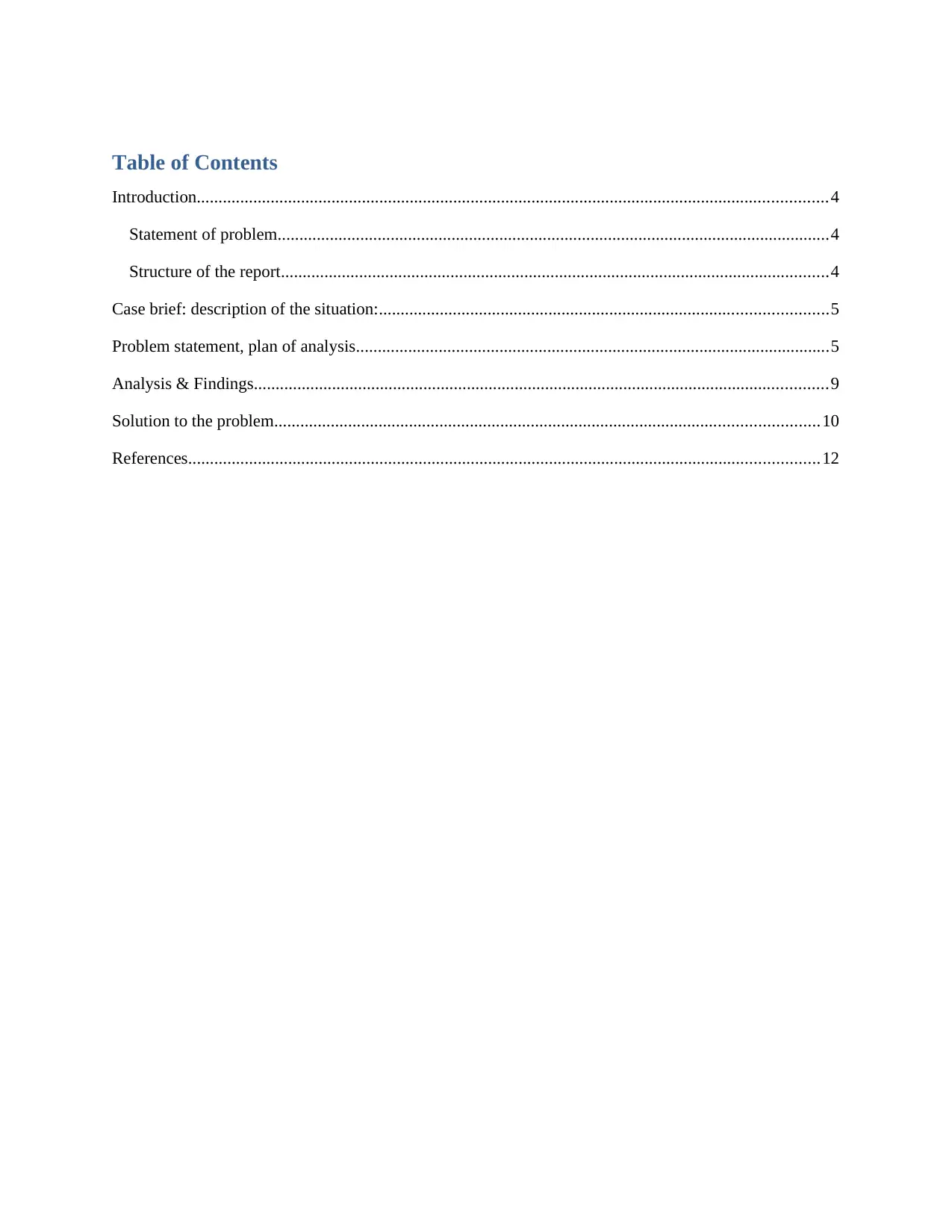
Table of Contents
Introduction.................................................................................................................................................4
Statement of problem...............................................................................................................................4
Structure of the report..............................................................................................................................4
Case brief: description of the situation:.......................................................................................................5
Problem statement, plan of analysis.............................................................................................................5
Analysis & Findings....................................................................................................................................9
Solution to the problem.............................................................................................................................10
References.................................................................................................................................................12
Introduction.................................................................................................................................................4
Statement of problem...............................................................................................................................4
Structure of the report..............................................................................................................................4
Case brief: description of the situation:.......................................................................................................5
Problem statement, plan of analysis.............................................................................................................5
Analysis & Findings....................................................................................................................................9
Solution to the problem.............................................................................................................................10
References.................................................................................................................................................12
⊘ This is a preview!⊘
Do you want full access?
Subscribe today to unlock all pages.

Trusted by 1+ million students worldwide
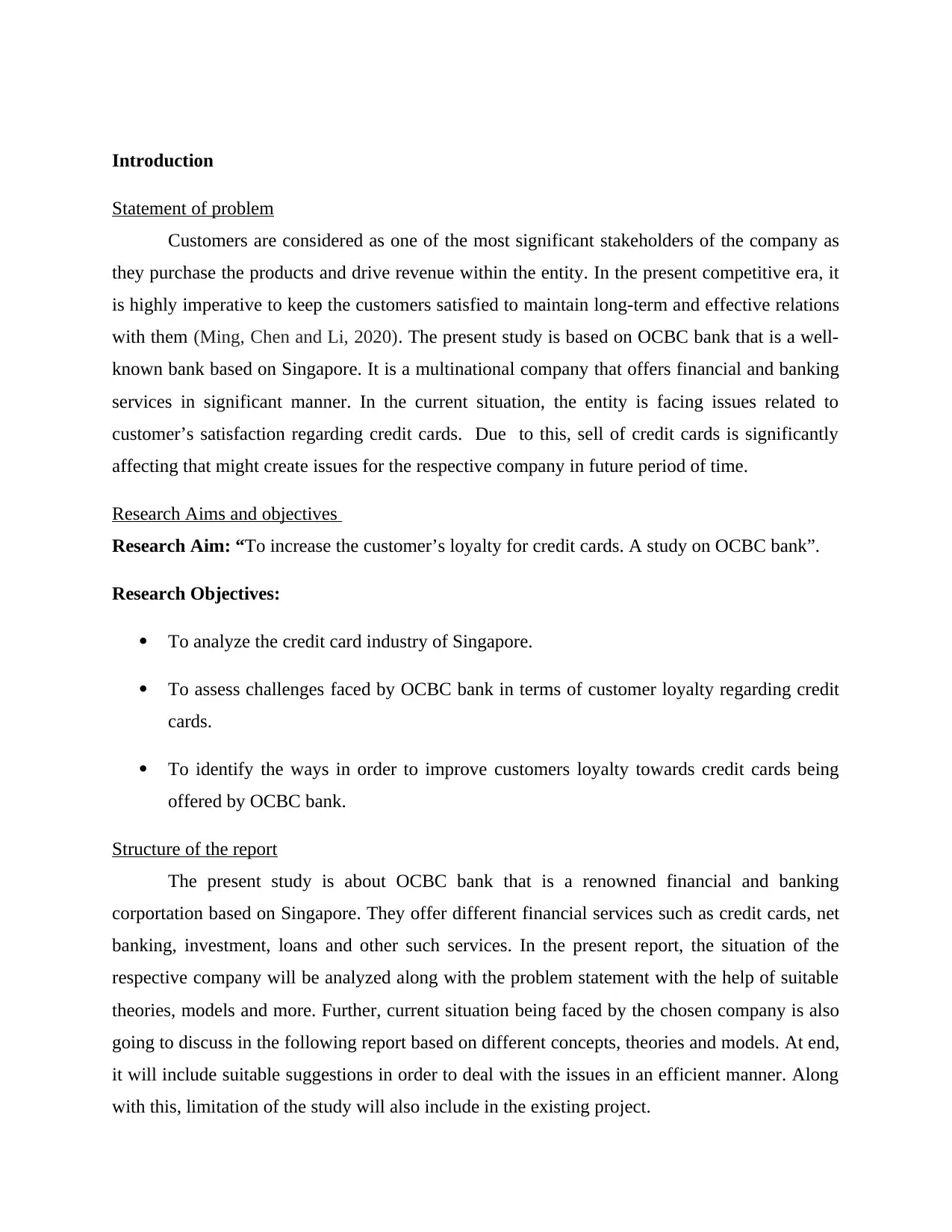
Introduction
Statement of problem
Customers are considered as one of the most significant stakeholders of the company as
they purchase the products and drive revenue within the entity. In the present competitive era, it
is highly imperative to keep the customers satisfied to maintain long-term and effective relations
with them (Ming, Chen and Li, 2020). The present study is based on OCBC bank that is a well-
known bank based on Singapore. It is a multinational company that offers financial and banking
services in significant manner. In the current situation, the entity is facing issues related to
customer’s satisfaction regarding credit cards. Due to this, sell of credit cards is significantly
affecting that might create issues for the respective company in future period of time.
Research Aims and objectives
Research Aim: “To increase the customer’s loyalty for credit cards. A study on OCBC bank”.
Research Objectives:
To analyze the credit card industry of Singapore.
To assess challenges faced by OCBC bank in terms of customer loyalty regarding credit
cards.
To identify the ways in order to improve customers loyalty towards credit cards being
offered by OCBC bank.
Structure of the report
The present study is about OCBC bank that is a renowned financial and banking
corportation based on Singapore. They offer different financial services such as credit cards, net
banking, investment, loans and other such services. In the present report, the situation of the
respective company will be analyzed along with the problem statement with the help of suitable
theories, models and more. Further, current situation being faced by the chosen company is also
going to discuss in the following report based on different concepts, theories and models. At end,
it will include suitable suggestions in order to deal with the issues in an efficient manner. Along
with this, limitation of the study will also include in the existing project.
Statement of problem
Customers are considered as one of the most significant stakeholders of the company as
they purchase the products and drive revenue within the entity. In the present competitive era, it
is highly imperative to keep the customers satisfied to maintain long-term and effective relations
with them (Ming, Chen and Li, 2020). The present study is based on OCBC bank that is a well-
known bank based on Singapore. It is a multinational company that offers financial and banking
services in significant manner. In the current situation, the entity is facing issues related to
customer’s satisfaction regarding credit cards. Due to this, sell of credit cards is significantly
affecting that might create issues for the respective company in future period of time.
Research Aims and objectives
Research Aim: “To increase the customer’s loyalty for credit cards. A study on OCBC bank”.
Research Objectives:
To analyze the credit card industry of Singapore.
To assess challenges faced by OCBC bank in terms of customer loyalty regarding credit
cards.
To identify the ways in order to improve customers loyalty towards credit cards being
offered by OCBC bank.
Structure of the report
The present study is about OCBC bank that is a renowned financial and banking
corportation based on Singapore. They offer different financial services such as credit cards, net
banking, investment, loans and other such services. In the present report, the situation of the
respective company will be analyzed along with the problem statement with the help of suitable
theories, models and more. Further, current situation being faced by the chosen company is also
going to discuss in the following report based on different concepts, theories and models. At end,
it will include suitable suggestions in order to deal with the issues in an efficient manner. Along
with this, limitation of the study will also include in the existing project.
Paraphrase This Document
Need a fresh take? Get an instant paraphrase of this document with our AI Paraphraser
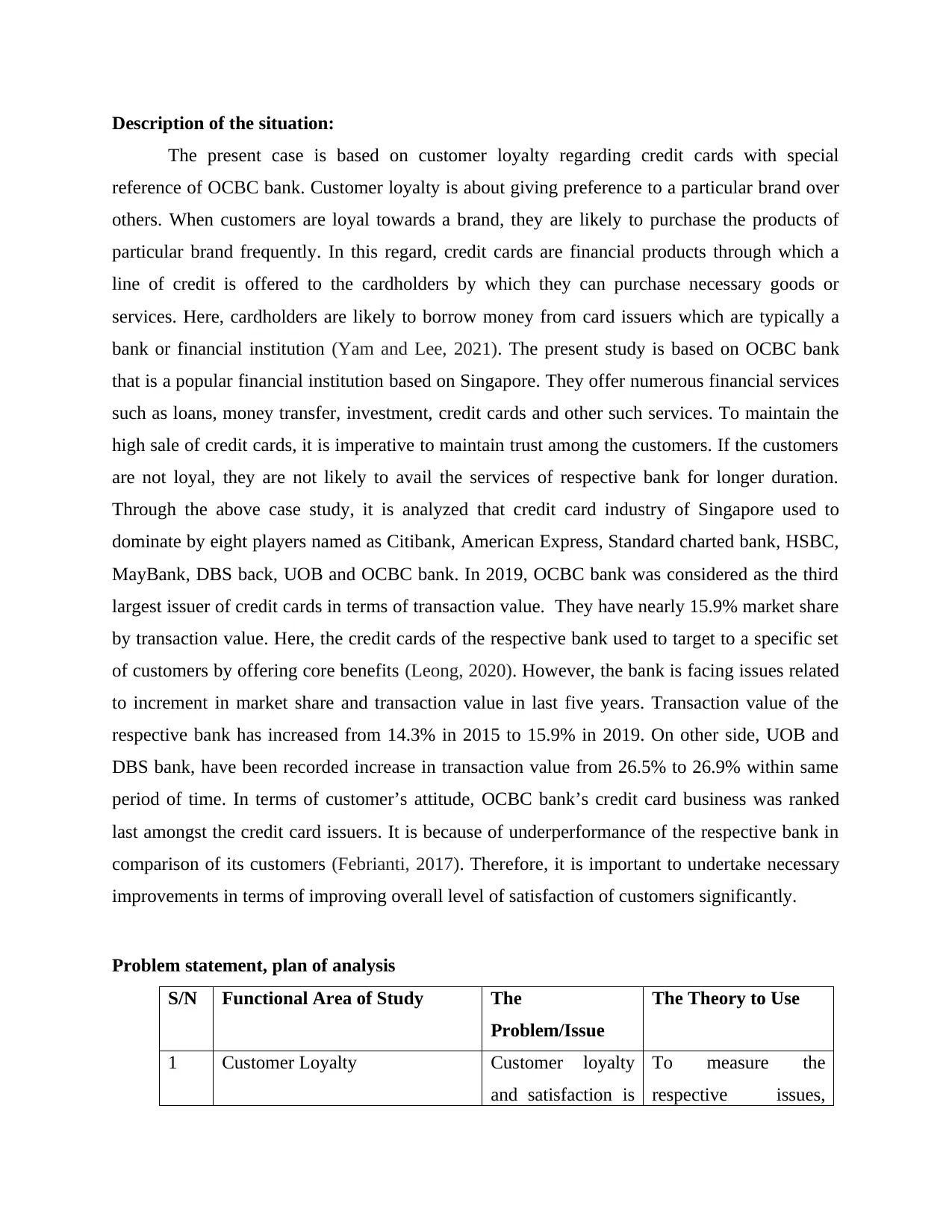
Description of the situation:
The present case is based on customer loyalty regarding credit cards with special
reference of OCBC bank. Customer loyalty is about giving preference to a particular brand over
others. When customers are loyal towards a brand, they are likely to purchase the products of
particular brand frequently. In this regard, credit cards are financial products through which a
line of credit is offered to the cardholders by which they can purchase necessary goods or
services. Here, cardholders are likely to borrow money from card issuers which are typically a
bank or financial institution (Yam and Lee, 2021). The present study is based on OCBC bank
that is a popular financial institution based on Singapore. They offer numerous financial services
such as loans, money transfer, investment, credit cards and other such services. To maintain the
high sale of credit cards, it is imperative to maintain trust among the customers. If the customers
are not loyal, they are not likely to avail the services of respective bank for longer duration.
Through the above case study, it is analyzed that credit card industry of Singapore used to
dominate by eight players named as Citibank, American Express, Standard charted bank, HSBC,
MayBank, DBS back, UOB and OCBC bank. In 2019, OCBC bank was considered as the third
largest issuer of credit cards in terms of transaction value. They have nearly 15.9% market share
by transaction value. Here, the credit cards of the respective bank used to target to a specific set
of customers by offering core benefits (Leong, 2020). However, the bank is facing issues related
to increment in market share and transaction value in last five years. Transaction value of the
respective bank has increased from 14.3% in 2015 to 15.9% in 2019. On other side, UOB and
DBS bank, have been recorded increase in transaction value from 26.5% to 26.9% within same
period of time. In terms of customer’s attitude, OCBC bank’s credit card business was ranked
last amongst the credit card issuers. It is because of underperformance of the respective bank in
comparison of its customers (Febrianti, 2017). Therefore, it is important to undertake necessary
improvements in terms of improving overall level of satisfaction of customers significantly.
Problem statement, plan of analysis
S/N Functional Area of Study The
Problem/Issue
The Theory to Use
1 Customer Loyalty Customer loyalty
and satisfaction is
To measure the
respective issues,
The present case is based on customer loyalty regarding credit cards with special
reference of OCBC bank. Customer loyalty is about giving preference to a particular brand over
others. When customers are loyal towards a brand, they are likely to purchase the products of
particular brand frequently. In this regard, credit cards are financial products through which a
line of credit is offered to the cardholders by which they can purchase necessary goods or
services. Here, cardholders are likely to borrow money from card issuers which are typically a
bank or financial institution (Yam and Lee, 2021). The present study is based on OCBC bank
that is a popular financial institution based on Singapore. They offer numerous financial services
such as loans, money transfer, investment, credit cards and other such services. To maintain the
high sale of credit cards, it is imperative to maintain trust among the customers. If the customers
are not loyal, they are not likely to avail the services of respective bank for longer duration.
Through the above case study, it is analyzed that credit card industry of Singapore used to
dominate by eight players named as Citibank, American Express, Standard charted bank, HSBC,
MayBank, DBS back, UOB and OCBC bank. In 2019, OCBC bank was considered as the third
largest issuer of credit cards in terms of transaction value. They have nearly 15.9% market share
by transaction value. Here, the credit cards of the respective bank used to target to a specific set
of customers by offering core benefits (Leong, 2020). However, the bank is facing issues related
to increment in market share and transaction value in last five years. Transaction value of the
respective bank has increased from 14.3% in 2015 to 15.9% in 2019. On other side, UOB and
DBS bank, have been recorded increase in transaction value from 26.5% to 26.9% within same
period of time. In terms of customer’s attitude, OCBC bank’s credit card business was ranked
last amongst the credit card issuers. It is because of underperformance of the respective bank in
comparison of its customers (Febrianti, 2017). Therefore, it is important to undertake necessary
improvements in terms of improving overall level of satisfaction of customers significantly.
Problem statement, plan of analysis
S/N Functional Area of Study The
Problem/Issue
The Theory to Use
1 Customer Loyalty Customer loyalty
and satisfaction is
To measure the
respective issues,
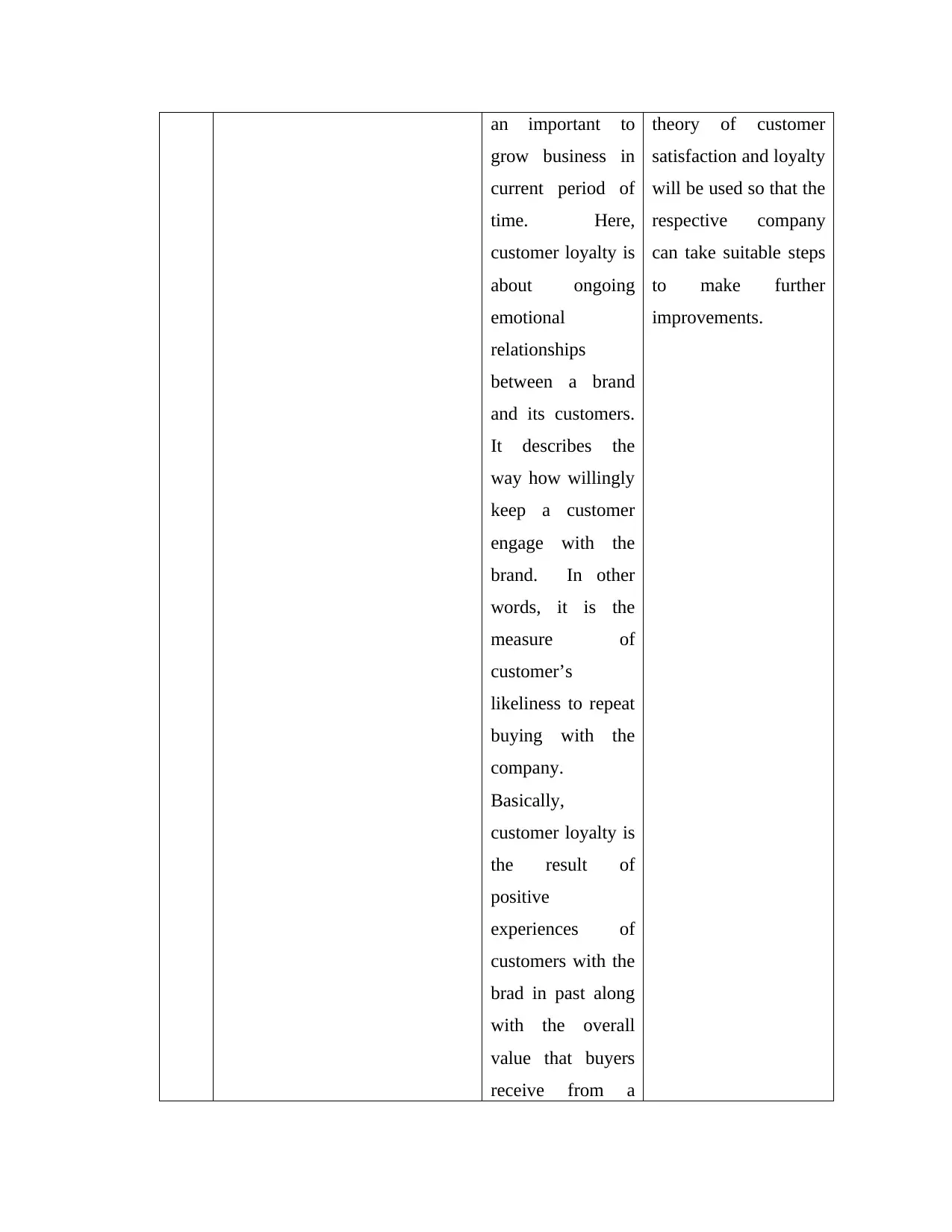
an important to
grow business in
current period of
time. Here,
customer loyalty is
about ongoing
emotional
relationships
between a brand
and its customers.
It describes the
way how willingly
keep a customer
engage with the
brand. In other
words, it is the
measure of
customer’s
likeliness to repeat
buying with the
company.
Basically,
customer loyalty is
the result of
positive
experiences of
customers with the
brad in past along
with the overall
value that buyers
receive from a
theory of customer
satisfaction and loyalty
will be used so that the
respective company
can take suitable steps
to make further
improvements.
grow business in
current period of
time. Here,
customer loyalty is
about ongoing
emotional
relationships
between a brand
and its customers.
It describes the
way how willingly
keep a customer
engage with the
brand. In other
words, it is the
measure of
customer’s
likeliness to repeat
buying with the
company.
Basically,
customer loyalty is
the result of
positive
experiences of
customers with the
brad in past along
with the overall
value that buyers
receive from a
theory of customer
satisfaction and loyalty
will be used so that the
respective company
can take suitable steps
to make further
improvements.
⊘ This is a preview!⊘
Do you want full access?
Subscribe today to unlock all pages.

Trusted by 1+ million students worldwide
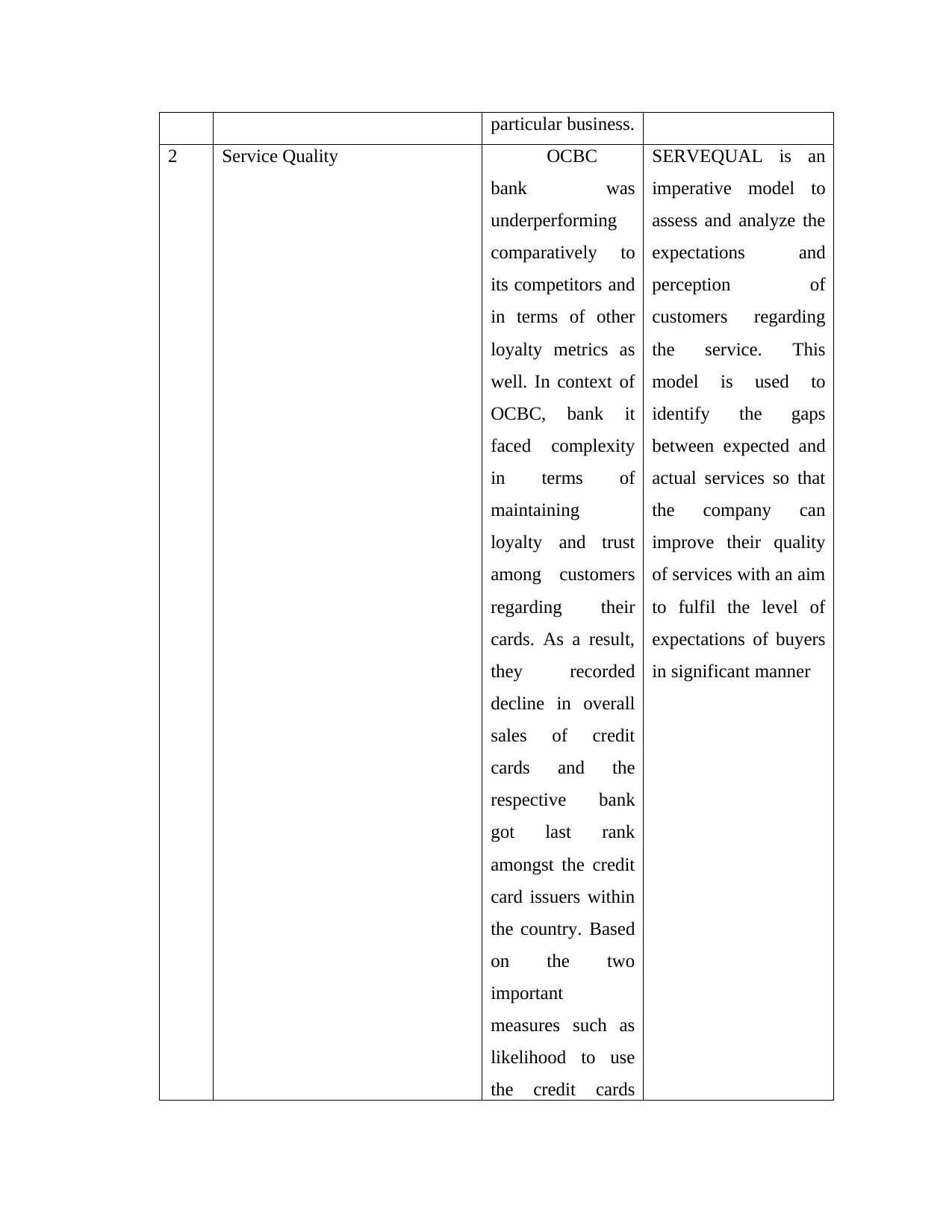
particular business.
2 Service Quality OCBC
bank was
underperforming
comparatively to
its competitors and
in terms of other
loyalty metrics as
well. In context of
OCBC, bank it
faced complexity
in terms of
maintaining
loyalty and trust
among customers
regarding their
cards. As a result,
they recorded
decline in overall
sales of credit
cards and the
respective bank
got last rank
amongst the credit
card issuers within
the country. Based
on the two
important
measures such as
likelihood to use
the credit cards
SERVEQUAL is an
imperative model to
assess and analyze the
expectations and
perception of
customers regarding
the service. This
model is used to
identify the gaps
between expected and
actual services so that
the company can
improve their quality
of services with an aim
to fulfil the level of
expectations of buyers
in significant manner
2 Service Quality OCBC
bank was
underperforming
comparatively to
its competitors and
in terms of other
loyalty metrics as
well. In context of
OCBC, bank it
faced complexity
in terms of
maintaining
loyalty and trust
among customers
regarding their
cards. As a result,
they recorded
decline in overall
sales of credit
cards and the
respective bank
got last rank
amongst the credit
card issuers within
the country. Based
on the two
important
measures such as
likelihood to use
the credit cards
SERVEQUAL is an
imperative model to
assess and analyze the
expectations and
perception of
customers regarding
the service. This
model is used to
identify the gaps
between expected and
actual services so that
the company can
improve their quality
of services with an aim
to fulfil the level of
expectations of buyers
in significant manner
Paraphrase This Document
Need a fresh take? Get an instant paraphrase of this document with our AI Paraphraser
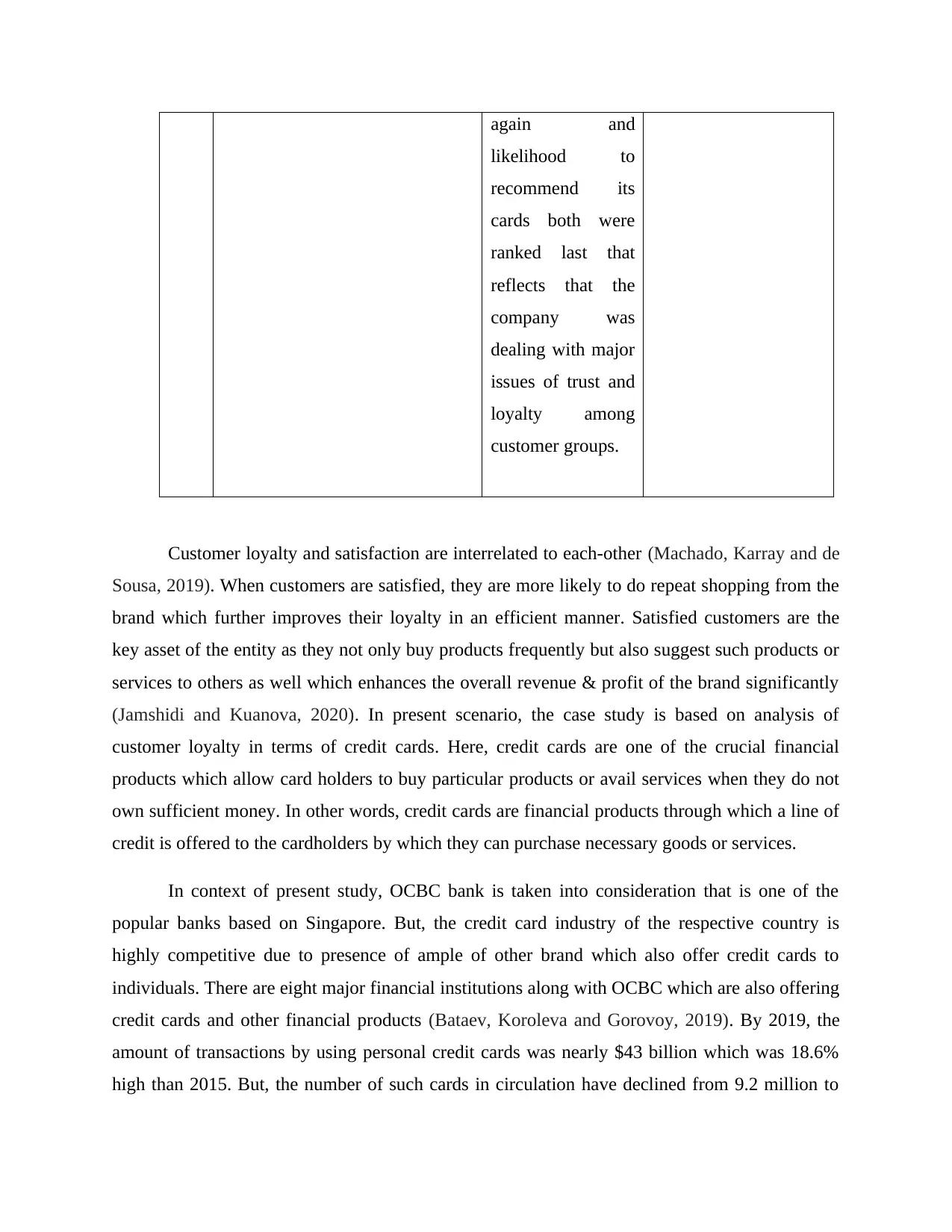
again and
likelihood to
recommend its
cards both were
ranked last that
reflects that the
company was
dealing with major
issues of trust and
loyalty among
customer groups.
Customer loyalty and satisfaction are interrelated to each-other (Machado, Karray and de
Sousa, 2019). When customers are satisfied, they are more likely to do repeat shopping from the
brand which further improves their loyalty in an efficient manner. Satisfied customers are the
key asset of the entity as they not only buy products frequently but also suggest such products or
services to others as well which enhances the overall revenue & profit of the brand significantly
(Jamshidi and Kuanova, 2020). In present scenario, the case study is based on analysis of
customer loyalty in terms of credit cards. Here, credit cards are one of the crucial financial
products which allow card holders to buy particular products or avail services when they do not
own sufficient money. In other words, credit cards are financial products through which a line of
credit is offered to the cardholders by which they can purchase necessary goods or services.
In context of present study, OCBC bank is taken into consideration that is one of the
popular banks based on Singapore. But, the credit card industry of the respective country is
highly competitive due to presence of ample of other brand which also offer credit cards to
individuals. There are eight major financial institutions along with OCBC which are also offering
credit cards and other financial products (Bataev, Koroleva and Gorovoy, 2019). By 2019, the
amount of transactions by using personal credit cards was nearly $43 billion which was 18.6%
high than 2015. But, the number of such cards in circulation have declined from 9.2 million to
likelihood to
recommend its
cards both were
ranked last that
reflects that the
company was
dealing with major
issues of trust and
loyalty among
customer groups.
Customer loyalty and satisfaction are interrelated to each-other (Machado, Karray and de
Sousa, 2019). When customers are satisfied, they are more likely to do repeat shopping from the
brand which further improves their loyalty in an efficient manner. Satisfied customers are the
key asset of the entity as they not only buy products frequently but also suggest such products or
services to others as well which enhances the overall revenue & profit of the brand significantly
(Jamshidi and Kuanova, 2020). In present scenario, the case study is based on analysis of
customer loyalty in terms of credit cards. Here, credit cards are one of the crucial financial
products which allow card holders to buy particular products or avail services when they do not
own sufficient money. In other words, credit cards are financial products through which a line of
credit is offered to the cardholders by which they can purchase necessary goods or services.
In context of present study, OCBC bank is taken into consideration that is one of the
popular banks based on Singapore. But, the credit card industry of the respective country is
highly competitive due to presence of ample of other brand which also offer credit cards to
individuals. There are eight major financial institutions along with OCBC which are also offering
credit cards and other financial products (Bataev, Koroleva and Gorovoy, 2019). By 2019, the
amount of transactions by using personal credit cards was nearly $43 billion which was 18.6%
high than 2015. But, the number of such cards in circulation have declined from 9.2 million to
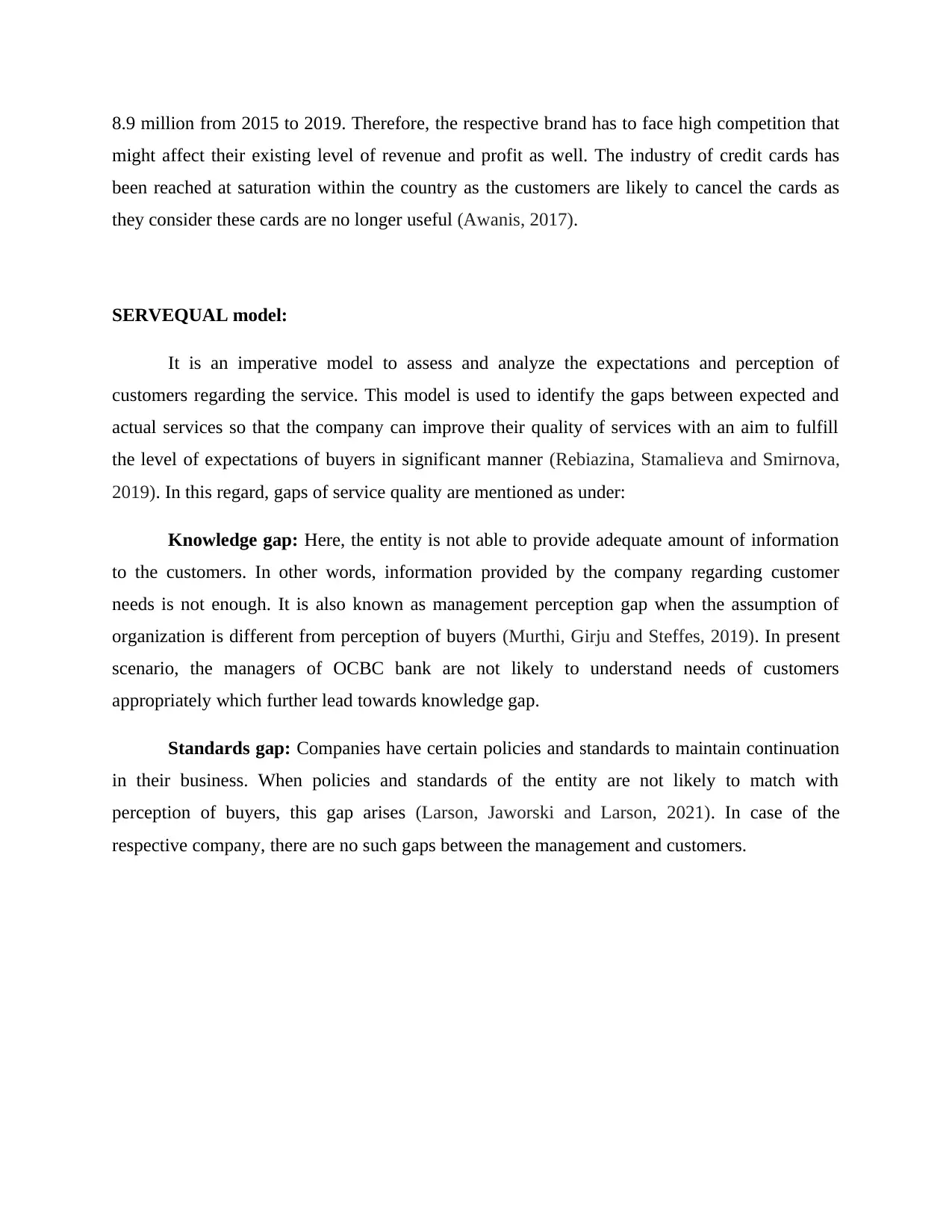
8.9 million from 2015 to 2019. Therefore, the respective brand has to face high competition that
might affect their existing level of revenue and profit as well. The industry of credit cards has
been reached at saturation within the country as the customers are likely to cancel the cards as
they consider these cards are no longer useful (Awanis, 2017).
SERVEQUAL model:
It is an imperative model to assess and analyze the expectations and perception of
customers regarding the service. This model is used to identify the gaps between expected and
actual services so that the company can improve their quality of services with an aim to fulfill
the level of expectations of buyers in significant manner (Rebiazina, Stamalieva and Smirnova,
2019). In this regard, gaps of service quality are mentioned as under:
Knowledge gap: Here, the entity is not able to provide adequate amount of information
to the customers. In other words, information provided by the company regarding customer
needs is not enough. It is also known as management perception gap when the assumption of
organization is different from perception of buyers (Murthi, Girju and Steffes, 2019). In present
scenario, the managers of OCBC bank are not likely to understand needs of customers
appropriately which further lead towards knowledge gap.
Standards gap: Companies have certain policies and standards to maintain continuation
in their business. When policies and standards of the entity are not likely to match with
perception of buyers, this gap arises (Larson, Jaworski and Larson, 2021). In case of the
respective company, there are no such gaps between the management and customers.
might affect their existing level of revenue and profit as well. The industry of credit cards has
been reached at saturation within the country as the customers are likely to cancel the cards as
they consider these cards are no longer useful (Awanis, 2017).
SERVEQUAL model:
It is an imperative model to assess and analyze the expectations and perception of
customers regarding the service. This model is used to identify the gaps between expected and
actual services so that the company can improve their quality of services with an aim to fulfill
the level of expectations of buyers in significant manner (Rebiazina, Stamalieva and Smirnova,
2019). In this regard, gaps of service quality are mentioned as under:
Knowledge gap: Here, the entity is not able to provide adequate amount of information
to the customers. In other words, information provided by the company regarding customer
needs is not enough. It is also known as management perception gap when the assumption of
organization is different from perception of buyers (Murthi, Girju and Steffes, 2019). In present
scenario, the managers of OCBC bank are not likely to understand needs of customers
appropriately which further lead towards knowledge gap.
Standards gap: Companies have certain policies and standards to maintain continuation
in their business. When policies and standards of the entity are not likely to match with
perception of buyers, this gap arises (Larson, Jaworski and Larson, 2021). In case of the
respective company, there are no such gaps between the management and customers.
⊘ This is a preview!⊘
Do you want full access?
Subscribe today to unlock all pages.

Trusted by 1+ million students worldwide
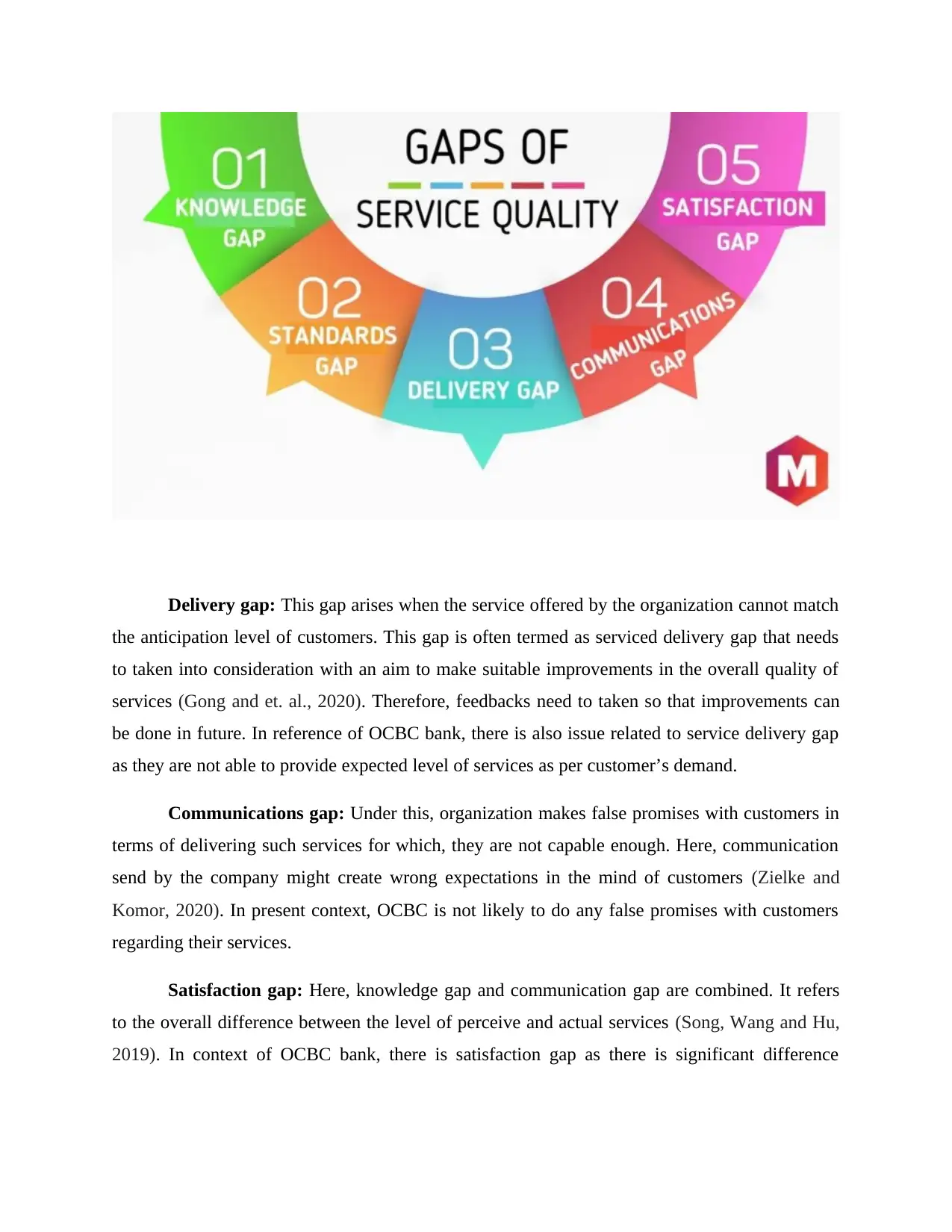
Delivery gap: This gap arises when the service offered by the organization cannot match
the anticipation level of customers. This gap is often termed as serviced delivery gap that needs
to taken into consideration with an aim to make suitable improvements in the overall quality of
services (Gong and et. al., 2020). Therefore, feedbacks need to taken so that improvements can
be done in future. In reference of OCBC bank, there is also issue related to service delivery gap
as they are not able to provide expected level of services as per customer’s demand.
Communications gap: Under this, organization makes false promises with customers in
terms of delivering such services for which, they are not capable enough. Here, communication
send by the company might create wrong expectations in the mind of customers (Zielke and
Komor, 2020). In present context, OCBC is not likely to do any false promises with customers
regarding their services.
Satisfaction gap: Here, knowledge gap and communication gap are combined. It refers
to the overall difference between the level of perceive and actual services (Song, Wang and Hu,
2019). In context of OCBC bank, there is satisfaction gap as there is significant difference
the anticipation level of customers. This gap is often termed as serviced delivery gap that needs
to taken into consideration with an aim to make suitable improvements in the overall quality of
services (Gong and et. al., 2020). Therefore, feedbacks need to taken so that improvements can
be done in future. In reference of OCBC bank, there is also issue related to service delivery gap
as they are not able to provide expected level of services as per customer’s demand.
Communications gap: Under this, organization makes false promises with customers in
terms of delivering such services for which, they are not capable enough. Here, communication
send by the company might create wrong expectations in the mind of customers (Zielke and
Komor, 2020). In present context, OCBC is not likely to do any false promises with customers
regarding their services.
Satisfaction gap: Here, knowledge gap and communication gap are combined. It refers
to the overall difference between the level of perceive and actual services (Song, Wang and Hu,
2019). In context of OCBC bank, there is satisfaction gap as there is significant difference
Paraphrase This Document
Need a fresh take? Get an instant paraphrase of this document with our AI Paraphraser
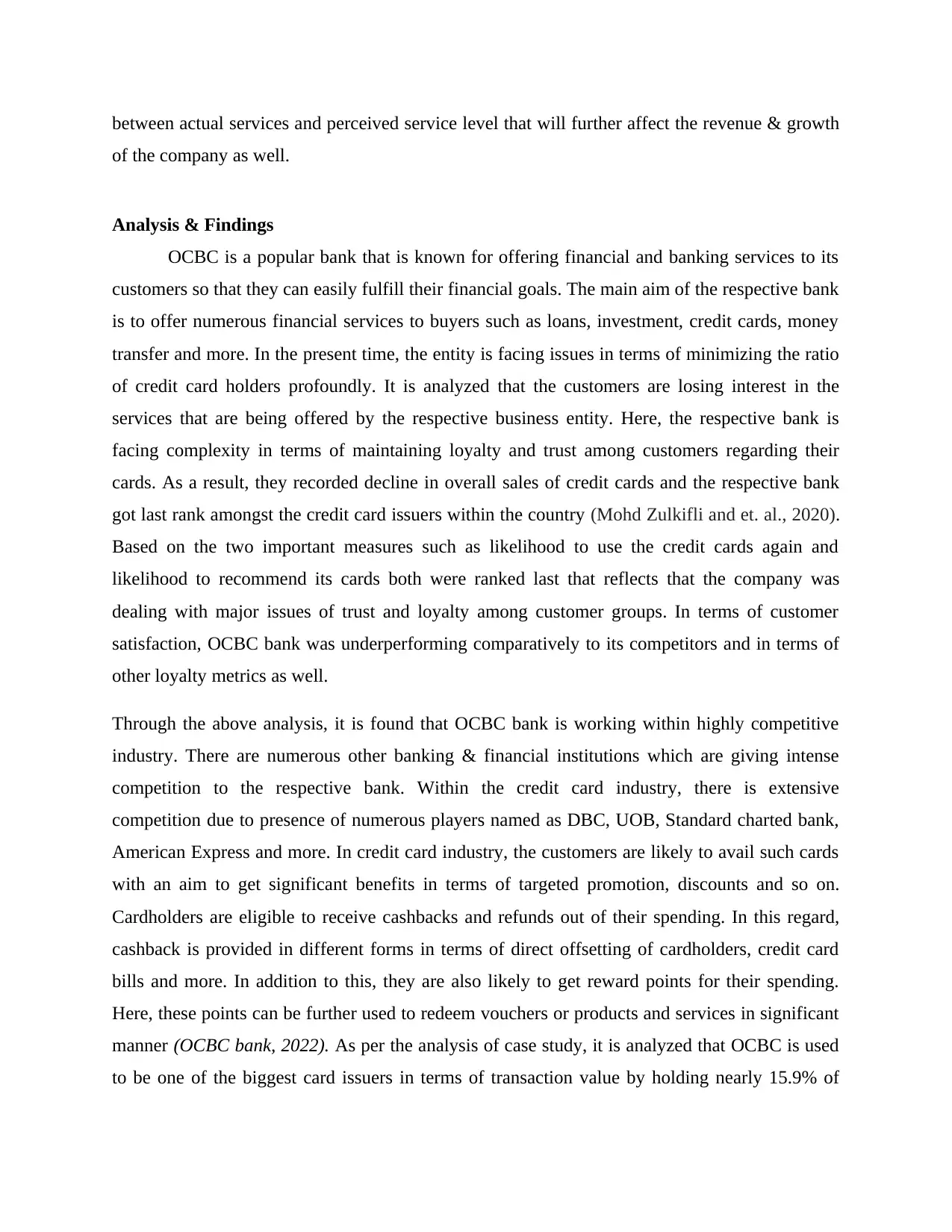
between actual services and perceived service level that will further affect the revenue & growth
of the company as well.
Analysis & Findings
OCBC is a popular bank that is known for offering financial and banking services to its
customers so that they can easily fulfill their financial goals. The main aim of the respective bank
is to offer numerous financial services to buyers such as loans, investment, credit cards, money
transfer and more. In the present time, the entity is facing issues in terms of minimizing the ratio
of credit card holders profoundly. It is analyzed that the customers are losing interest in the
services that are being offered by the respective business entity. Here, the respective bank is
facing complexity in terms of maintaining loyalty and trust among customers regarding their
cards. As a result, they recorded decline in overall sales of credit cards and the respective bank
got last rank amongst the credit card issuers within the country (Mohd Zulkifli and et. al., 2020).
Based on the two important measures such as likelihood to use the credit cards again and
likelihood to recommend its cards both were ranked last that reflects that the company was
dealing with major issues of trust and loyalty among customer groups. In terms of customer
satisfaction, OCBC bank was underperforming comparatively to its competitors and in terms of
other loyalty metrics as well.
Through the above analysis, it is found that OCBC bank is working within highly competitive
industry. There are numerous other banking & financial institutions which are giving intense
competition to the respective bank. Within the credit card industry, there is extensive
competition due to presence of numerous players named as DBC, UOB, Standard charted bank,
American Express and more. In credit card industry, the customers are likely to avail such cards
with an aim to get significant benefits in terms of targeted promotion, discounts and so on.
Cardholders are eligible to receive cashbacks and refunds out of their spending. In this regard,
cashback is provided in different forms in terms of direct offsetting of cardholders, credit card
bills and more. In addition to this, they are also likely to get reward points for their spending.
Here, these points can be further used to redeem vouchers or products and services in significant
manner (OCBC bank, 2022). As per the analysis of case study, it is analyzed that OCBC is used
to be one of the biggest card issuers in terms of transaction value by holding nearly 15.9% of
of the company as well.
Analysis & Findings
OCBC is a popular bank that is known for offering financial and banking services to its
customers so that they can easily fulfill their financial goals. The main aim of the respective bank
is to offer numerous financial services to buyers such as loans, investment, credit cards, money
transfer and more. In the present time, the entity is facing issues in terms of minimizing the ratio
of credit card holders profoundly. It is analyzed that the customers are losing interest in the
services that are being offered by the respective business entity. Here, the respective bank is
facing complexity in terms of maintaining loyalty and trust among customers regarding their
cards. As a result, they recorded decline in overall sales of credit cards and the respective bank
got last rank amongst the credit card issuers within the country (Mohd Zulkifli and et. al., 2020).
Based on the two important measures such as likelihood to use the credit cards again and
likelihood to recommend its cards both were ranked last that reflects that the company was
dealing with major issues of trust and loyalty among customer groups. In terms of customer
satisfaction, OCBC bank was underperforming comparatively to its competitors and in terms of
other loyalty metrics as well.
Through the above analysis, it is found that OCBC bank is working within highly competitive
industry. There are numerous other banking & financial institutions which are giving intense
competition to the respective bank. Within the credit card industry, there is extensive
competition due to presence of numerous players named as DBC, UOB, Standard charted bank,
American Express and more. In credit card industry, the customers are likely to avail such cards
with an aim to get significant benefits in terms of targeted promotion, discounts and so on.
Cardholders are eligible to receive cashbacks and refunds out of their spending. In this regard,
cashback is provided in different forms in terms of direct offsetting of cardholders, credit card
bills and more. In addition to this, they are also likely to get reward points for their spending.
Here, these points can be further used to redeem vouchers or products and services in significant
manner (OCBC bank, 2022). As per the analysis of case study, it is analyzed that OCBC is used
to be one of the biggest card issuers in terms of transaction value by holding nearly 15.9% of
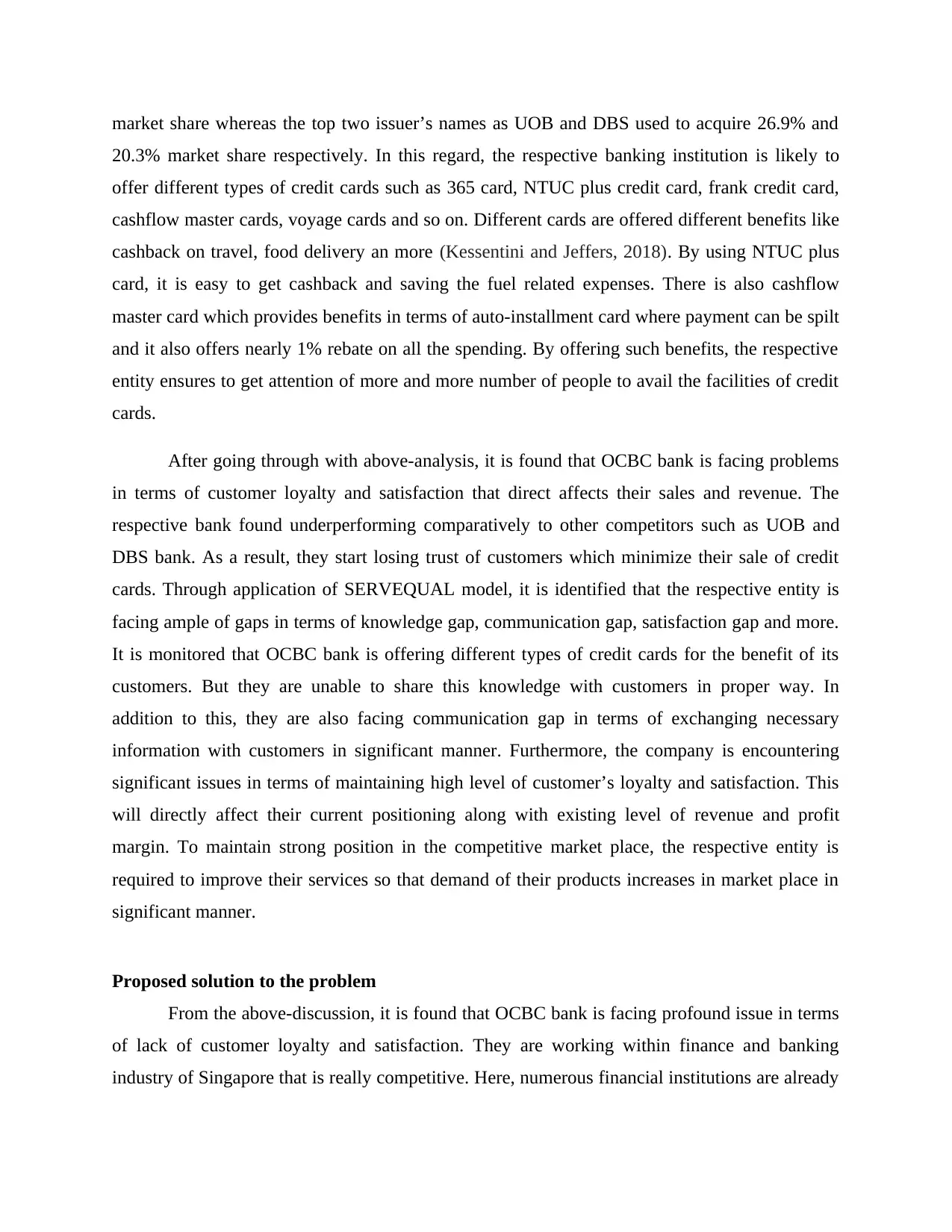
market share whereas the top two issuer’s names as UOB and DBS used to acquire 26.9% and
20.3% market share respectively. In this regard, the respective banking institution is likely to
offer different types of credit cards such as 365 card, NTUC plus credit card, frank credit card,
cashflow master cards, voyage cards and so on. Different cards are offered different benefits like
cashback on travel, food delivery an more (Kessentini and Jeffers, 2018). By using NTUC plus
card, it is easy to get cashback and saving the fuel related expenses. There is also cashflow
master card which provides benefits in terms of auto-installment card where payment can be spilt
and it also offers nearly 1% rebate on all the spending. By offering such benefits, the respective
entity ensures to get attention of more and more number of people to avail the facilities of credit
cards.
After going through with above-analysis, it is found that OCBC bank is facing problems
in terms of customer loyalty and satisfaction that direct affects their sales and revenue. The
respective bank found underperforming comparatively to other competitors such as UOB and
DBS bank. As a result, they start losing trust of customers which minimize their sale of credit
cards. Through application of SERVEQUAL model, it is identified that the respective entity is
facing ample of gaps in terms of knowledge gap, communication gap, satisfaction gap and more.
It is monitored that OCBC bank is offering different types of credit cards for the benefit of its
customers. But they are unable to share this knowledge with customers in proper way. In
addition to this, they are also facing communication gap in terms of exchanging necessary
information with customers in significant manner. Furthermore, the company is encountering
significant issues in terms of maintaining high level of customer’s loyalty and satisfaction. This
will directly affect their current positioning along with existing level of revenue and profit
margin. To maintain strong position in the competitive market place, the respective entity is
required to improve their services so that demand of their products increases in market place in
significant manner.
Proposed solution to the problem
From the above-discussion, it is found that OCBC bank is facing profound issue in terms
of lack of customer loyalty and satisfaction. They are working within finance and banking
industry of Singapore that is really competitive. Here, numerous financial institutions are already
20.3% market share respectively. In this regard, the respective banking institution is likely to
offer different types of credit cards such as 365 card, NTUC plus credit card, frank credit card,
cashflow master cards, voyage cards and so on. Different cards are offered different benefits like
cashback on travel, food delivery an more (Kessentini and Jeffers, 2018). By using NTUC plus
card, it is easy to get cashback and saving the fuel related expenses. There is also cashflow
master card which provides benefits in terms of auto-installment card where payment can be spilt
and it also offers nearly 1% rebate on all the spending. By offering such benefits, the respective
entity ensures to get attention of more and more number of people to avail the facilities of credit
cards.
After going through with above-analysis, it is found that OCBC bank is facing problems
in terms of customer loyalty and satisfaction that direct affects their sales and revenue. The
respective bank found underperforming comparatively to other competitors such as UOB and
DBS bank. As a result, they start losing trust of customers which minimize their sale of credit
cards. Through application of SERVEQUAL model, it is identified that the respective entity is
facing ample of gaps in terms of knowledge gap, communication gap, satisfaction gap and more.
It is monitored that OCBC bank is offering different types of credit cards for the benefit of its
customers. But they are unable to share this knowledge with customers in proper way. In
addition to this, they are also facing communication gap in terms of exchanging necessary
information with customers in significant manner. Furthermore, the company is encountering
significant issues in terms of maintaining high level of customer’s loyalty and satisfaction. This
will directly affect their current positioning along with existing level of revenue and profit
margin. To maintain strong position in the competitive market place, the respective entity is
required to improve their services so that demand of their products increases in market place in
significant manner.
Proposed solution to the problem
From the above-discussion, it is found that OCBC bank is facing profound issue in terms
of lack of customer loyalty and satisfaction. They are working within finance and banking
industry of Singapore that is really competitive. Here, numerous financial institutions are already
⊘ This is a preview!⊘
Do you want full access?
Subscribe today to unlock all pages.

Trusted by 1+ million students worldwide
1 out of 17
Related Documents
Your All-in-One AI-Powered Toolkit for Academic Success.
+13062052269
info@desklib.com
Available 24*7 on WhatsApp / Email
![[object Object]](/_next/static/media/star-bottom.7253800d.svg)
Unlock your academic potential
Copyright © 2020–2025 A2Z Services. All Rights Reserved. Developed and managed by ZUCOL.




